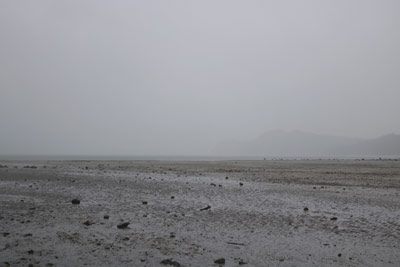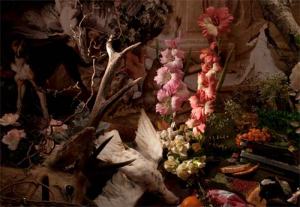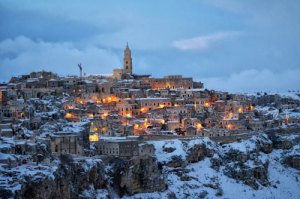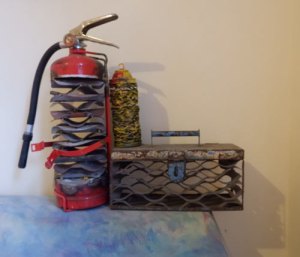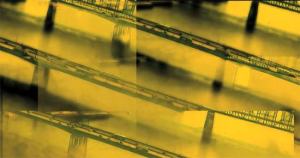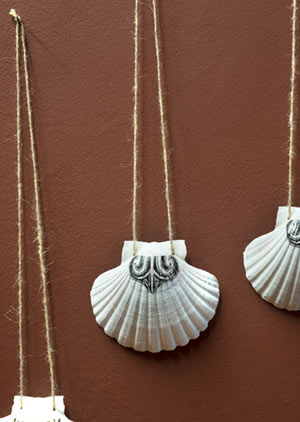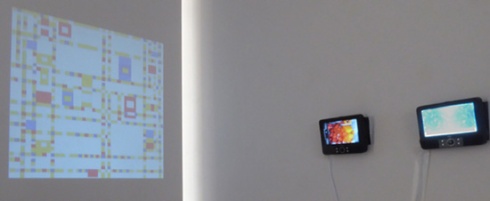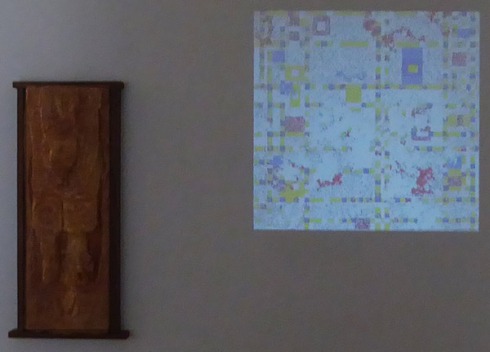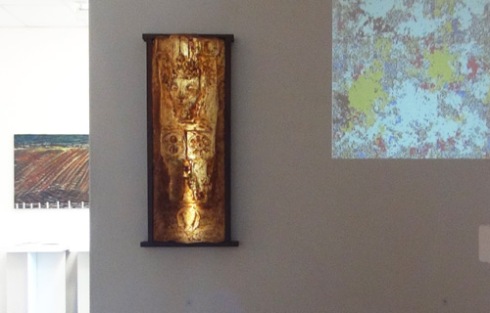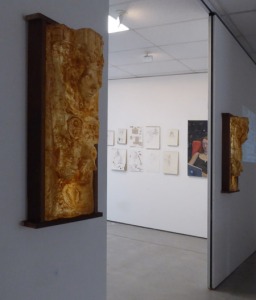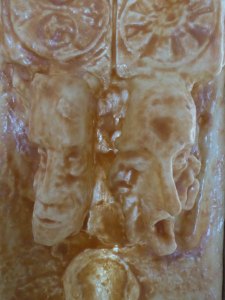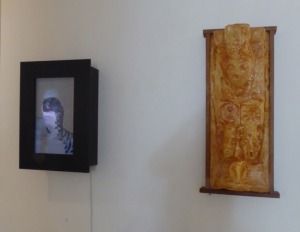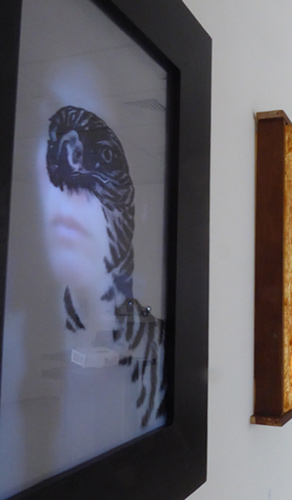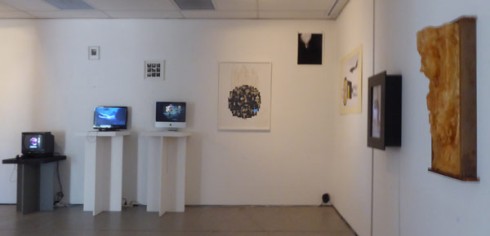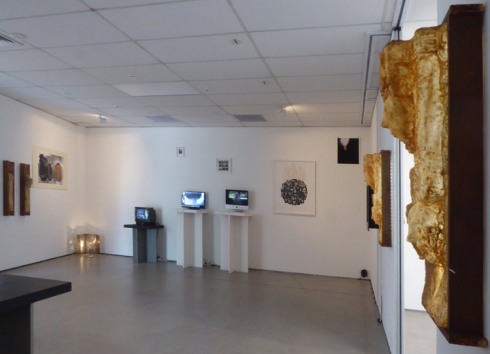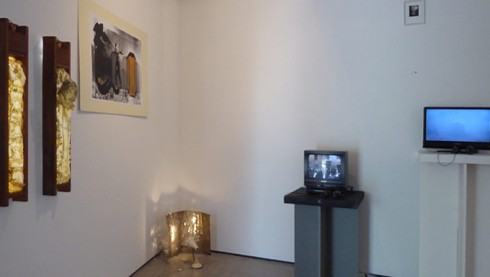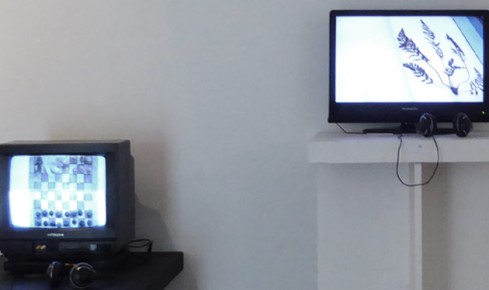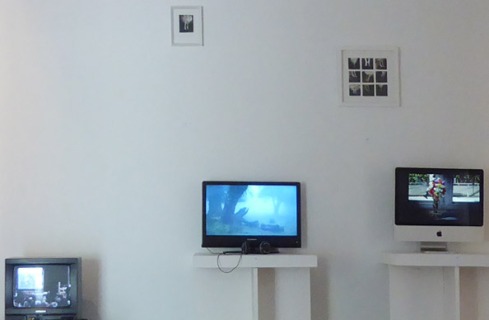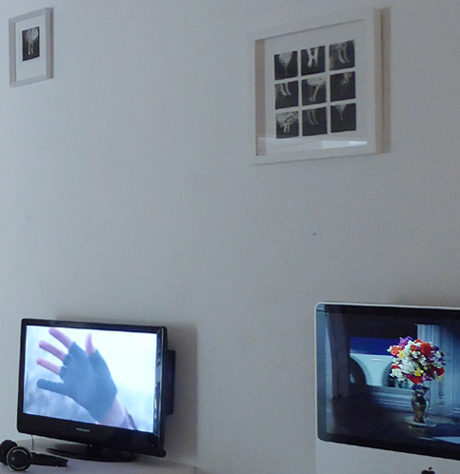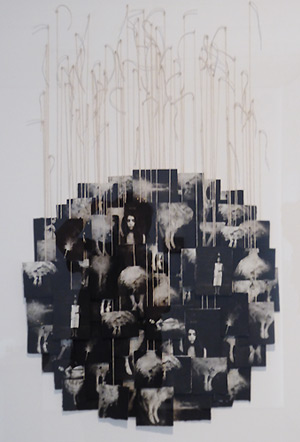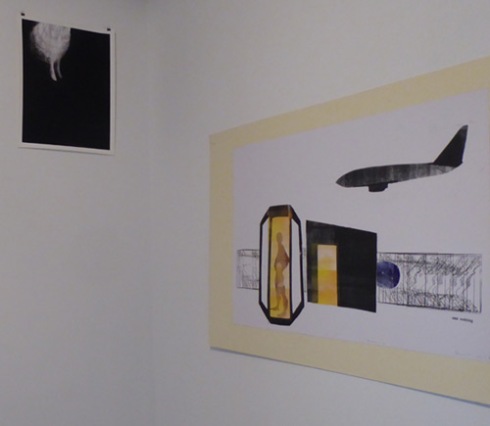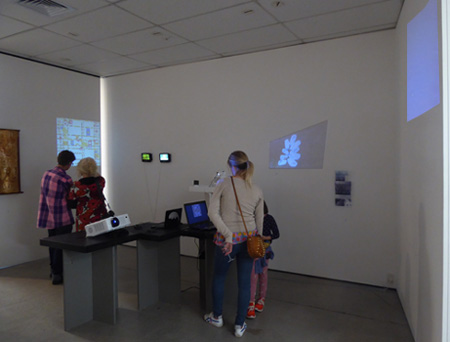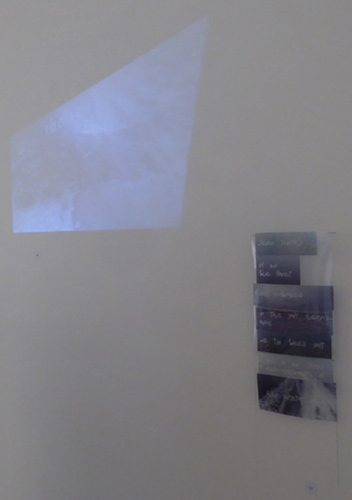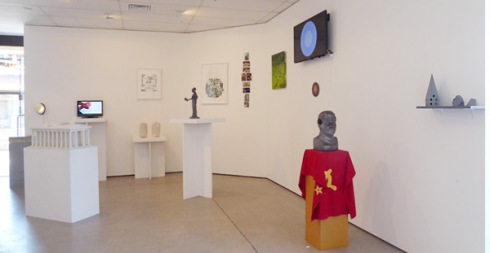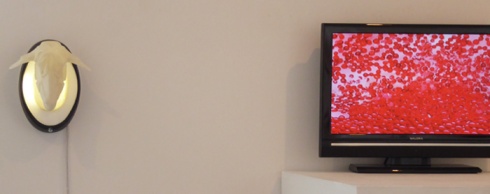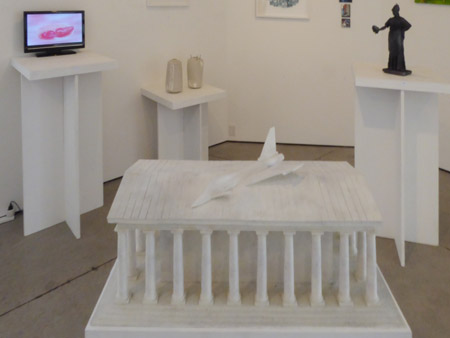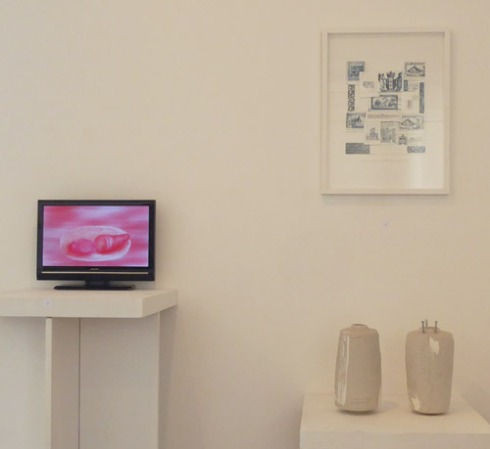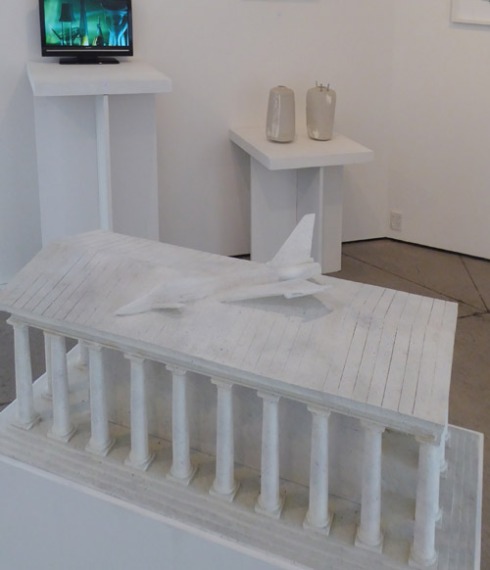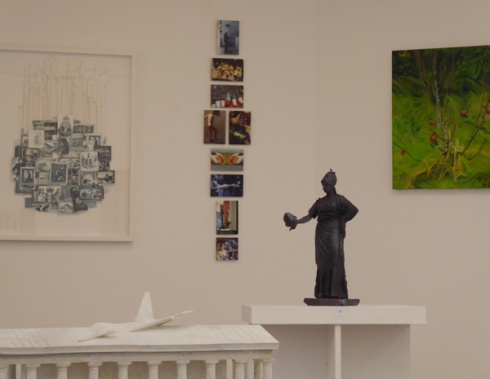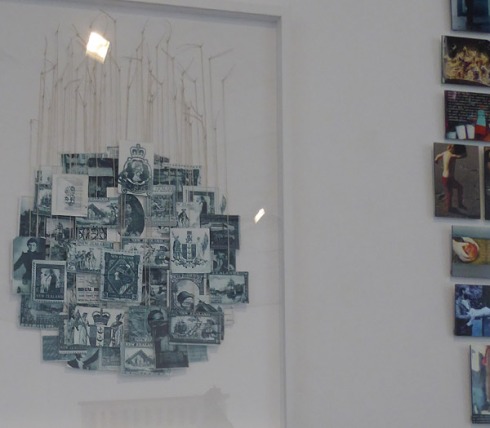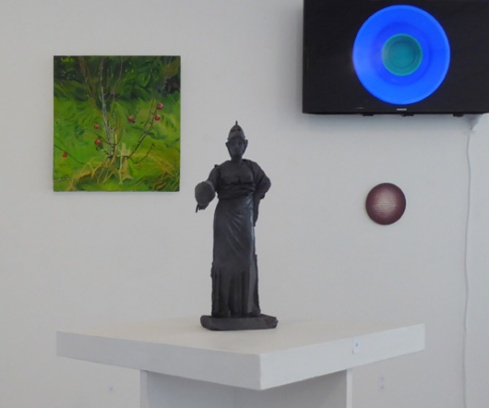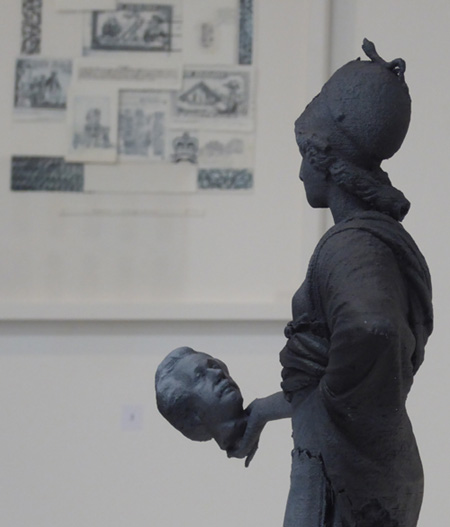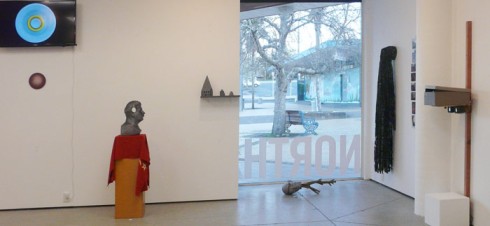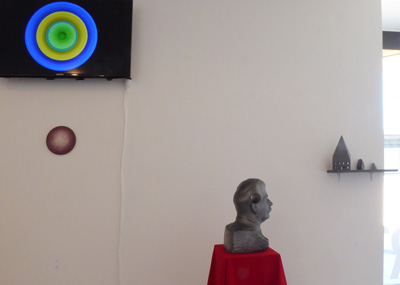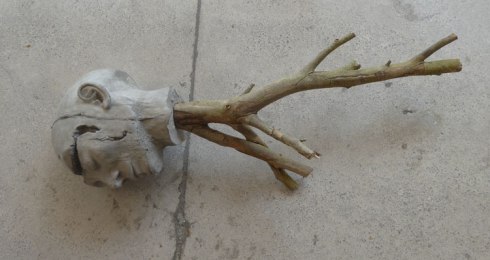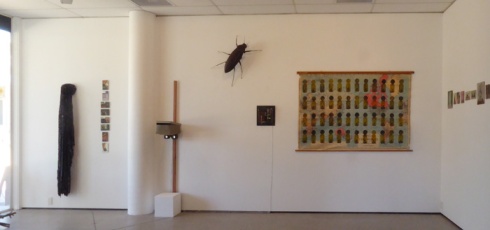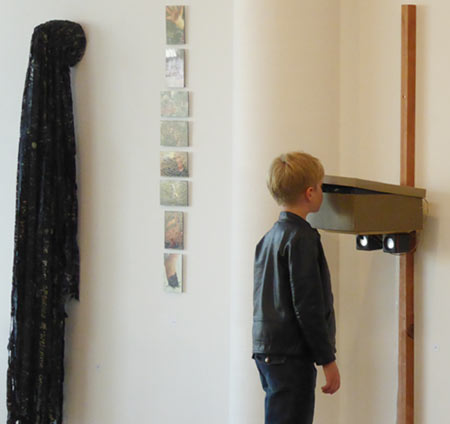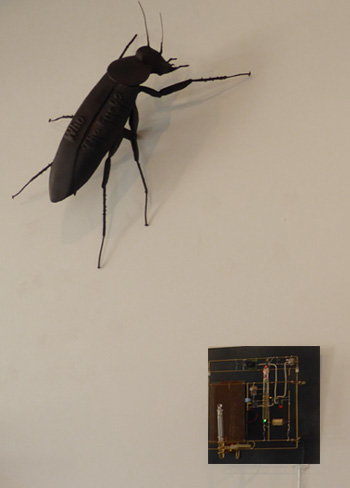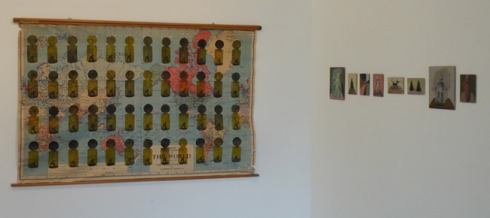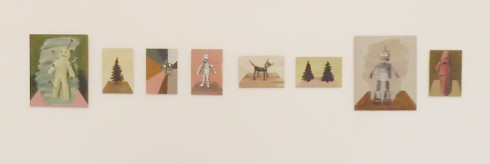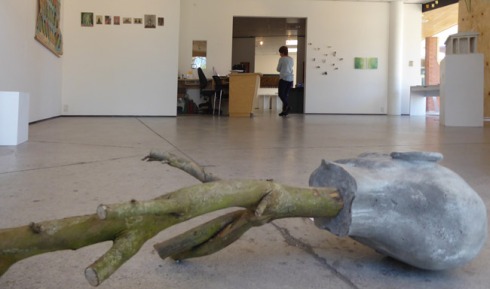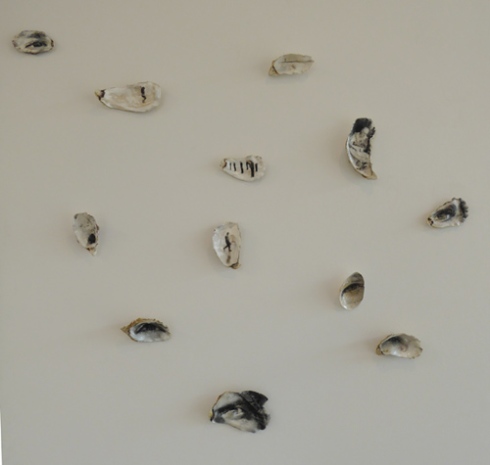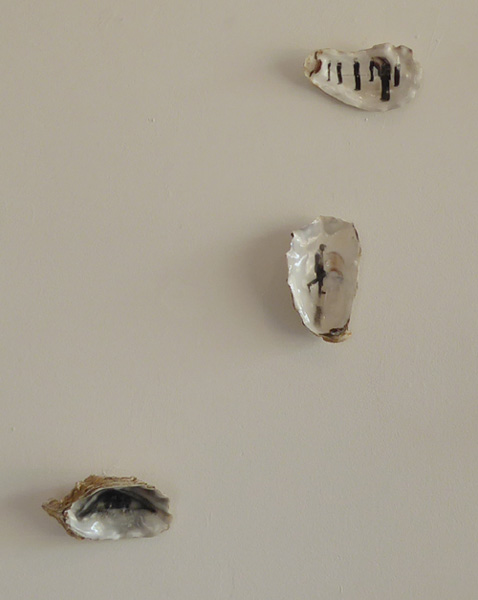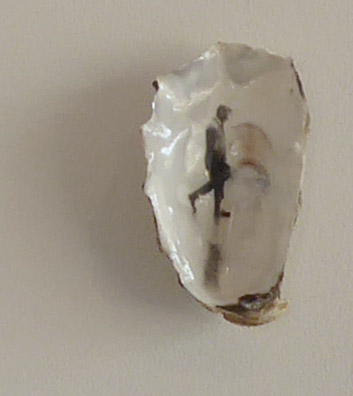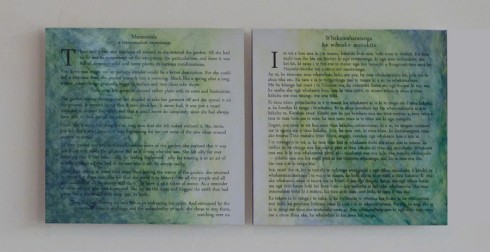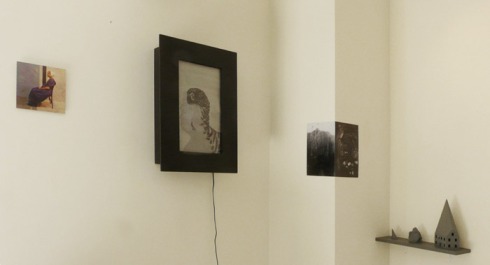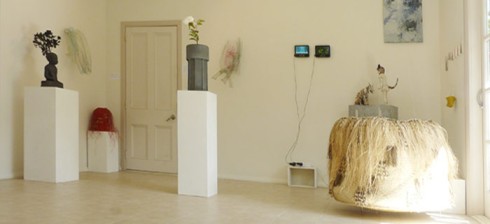
Left to Right: St Cyricus, plastic, artificial flowers and Epoxy, 40 x 15 x 60 cm by Brit Bunkley; Netting, wire and acrylic, by Michelle Backhouse; Pouhine (red basket form), harakeke (flax), muka (flax fibre), commercial dyes. Raranga + whatu (Māori weaving techniques) by Adrienne Spratt; Lake Alice Water-tower, plastic, paint and artificial flowers, 60 x 12 x 12 cm, by Brit Bunkley; Into the pink, wire and acrylic, by Michelle Backhouse; Cleaning the Air, 43 sec video + Daily Dishes, 7 min 11 sec video by Pietertje van Splunter; Oil on canvas by Edward Walton; From the War / No War series, six laser print on card reliefs (obliquely on the wall) by Hohepa; Kete Pingao, 20 x 10 cm, woven basket by Brenda Tuuta; Herenga rahi (Big connections/confinement), harakeke, muka, tanekaha bark and paru dyes. Raranga, whatu (Māori weaving techniques, suspended basket) by Adrienne Spratt.
The Poetic Condition was a show of multifaceted visions in diverse media on engaged personal connections with history, culture and social worlds by 13 artists based in the Hague and New Zealand.
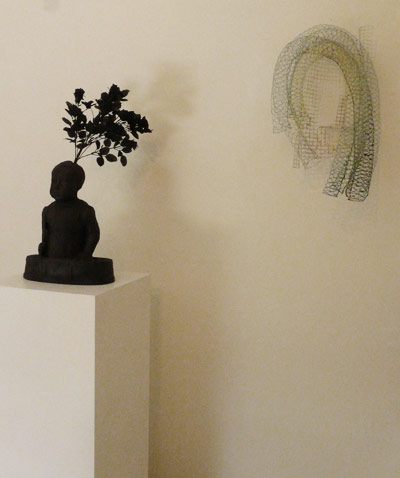
Left to Right: St Cyricus by Brit Bunkley, Netting by Michelle Backhouse.
Brit Bunkley’s
St Cyricus looks like a doll from a by gone age but is a 3D scan of a 1470-80 marble statue of the child saint by Italian Renaissance sculptor, Francesco Laurana.
Bunkley saw this statue in the Los Angeles Getty museum
(view this statue) and was intrigued by the idea of a saint being a child. The story goes that in about 200-300 AD, that the child while being held by the governor (while the child’s mother, Saint Julitta, was on trial) the child stated that he was also a Christian and bit the governor. For this act of defiance the child was killed. Other stories tell of him being brutally tortured. The Renaissance artist incorporated symbols of sainthood such as the palm and laurel branches, and the cut off body suggests that he might be in a cauldron. The recasting of this in dark grey plastic with the addition of artificial flowers, makes the work an enigma because both aspects of social history (the religious and the art context of the statue at present) are simultaneously referenced and distanced.
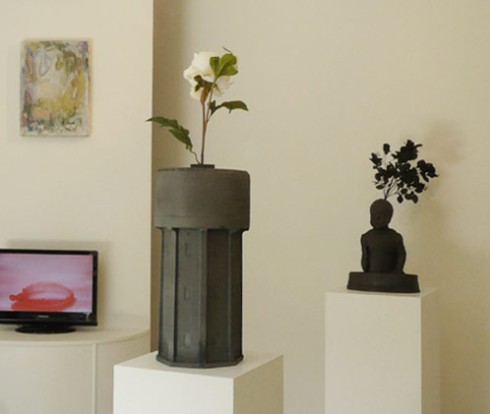
L to R: Een Rode Citroen (A red lemon), 2015, 9 min 53 sec., video + soundscape by Anne Wellmer; Oil on canvas by Edward Walton; Lake Alice Water-tower + St Cyricus by Brit Bunkley.
, is another sculpture by Brit Bunkley created with 3D printer from scans of an existing structure also with a flower insert. Perhaps this work is nature vs culture, or nature out of culture. Water towers are still iconic structures in small New Zealand towns. This tower, in particular, makes reference to another aspect of New Zealand’s abject history, the infamous rural pyschiatric institution, Lake Alice. Like many New Zealand psychiatric hospitals, Lake Alice was self-sufficient, with its own farm, workshop, bakery, laundry, and fire station as well as its now questionable practices on its inmates. It closed in 1999.
The flower could be a sign that nature always endures, always has some measure of self-sufficency, while the static cultural innate object gains or loses meaning if its function is lost. However in foregrounding the materiality of these sculptures, such as details in the greyer than grey facades, he reminds us that this is still artifice, it is still plastic, and in the end this is a sculpture of oppositions that forces us to take our own stance.
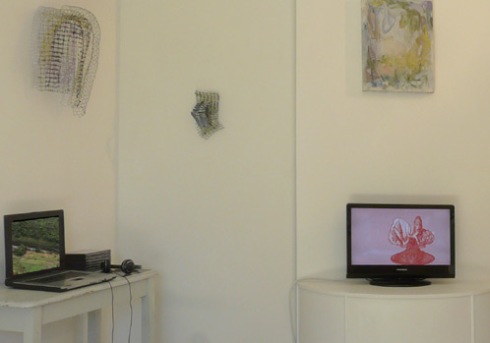
Left to Right: Kāinga a roto (Home Within), suite of 5 videos (on laptop) by Sonja van Kerkhoff, Adumbrate No. 2, 2014, wire netting + Untitled, 2017, wire netting and building paper by Michelle Backhouse; Oil on canvas by Edward Walton; Een Rode Citroen (A red lemon), 2015, animation, 9′ 53” by Anne Wellmer. Soundtrack: Anne Wellmer. Drawings: Geerten Ten Bosch. Animation: Harriët van Reek. Text excerpt from The Writing Notebooks (edited in English by Susan Sellers) by Hélène Cixous. Voice: Stephie Büttrich-Kolman.
The gallery space was dominated by Anne Wellmer’s soundscapes from her 3 videos played in a loop. Medieval chanting, whisperings in German and English, sounds, narration, instructional or provocative texts connected us with individualistic collaborative worlds. The 9 minute animation
Een Rode Citroen (A red lemon), was a surreal exploration of a mutating organic inner and outer ‘strange-scape’ in which eerie sounds and the evocative text (in English) by Jewish-French, Algerian-born poststructuralist feminist, Hélène Cixous complemented biological galatical worlds.

Still from Vox Sanguinis (Voice of the blood), 1’53”. Video and soundtrack: Anne Wellmer. Video and soundtrack: Anne Wellmer. Camera: Florian Cramer. Voice: Cora Schmeiser. Music: “O rubor sanguinis” by Hildegard of Bingen. Trumpet: Heimo Wallner. Silent performer and stage design: Geerten Ten Bosch
Another video
Vox Sanguinis (Voice of the blood), was a teaser for the music theater performance by Cora Schmeiser with new compositions inspired by Hildegard of Bingen (1098-1179) by 4 Dutch composers: Giuliano Bracci, Kate Moore, Lukas Simonis, Boudewijn Tarenskeen and Aliona Yurtsevich. The sound design and live electronics were by Anne Wellmer. Vox Sanguinis toured to four cities in the Netherlands in 2015.
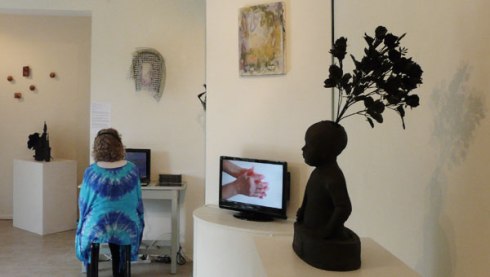
Left to Right: Warm Memories, emulsion on five suspended teabags by Martje Zandboer; The Happiest place on earth, plastic, paint and artifical flowers, 55 x 45 x 10 cm, by Brit Bunkley; Kāinga a roto (Home Within), videos (on laptop) by Sonja van Kerkhoff; Adumbrate No. 2, 2014, wire netting + Untitled, 2017, wire netting and building paper by Michelle Backhouse; Oil on canvas by Edward Walton; Transfusionen (Transfusions), 2015, video with sound, 2′ 43” by Anne Wellmer. Sound: Anne Wellmer. Hands: Geerten Ten Bosch. Voice: Cora Schmeiser. Music fragment from BLAST (2015) by Lukas Simonis. Text fragment from ‘Della Religione Christiana’ by Marsilio Ficino (1433-1499), first published in Italian in 1568. This German translation was published in ‘Das Blut: Symbolik und Magie’ (Blood: Symbolism and Magic) (2004) by Piero Camporesi; St Cyricus 3D plastic print sculpture by Brit Bunkley.
The whisperings in German in the video
Transfusionen (Transfusions) spoke of medieval beliefs about witches using the blood of children to make medicine and the various uses (transfusions or transmutations) of this medicine, including the making of wine.
The sounds from these three videos were the soundscape of this show unless one put on headphones to listen to two of the other videos in the exhibition. Under two spatial abstractions of wire by Michelle Backhouse was the suite of videos, Kāinga a roto (Home Within), by Sonja van Kerkhoff (More >>) and around the corner was the 29 minute video, Et in Arcadia Ego by Channa Boon.

Left to Right: Et in Arcadia Ego, 29 min video by Channa Boon; Love of the other, 10 cm diameter, print on aluminium by Sonja van Kerkhoff; Muka and taniko kete, harakeke muka, tanekaha bark + paru dyes. Whatu and taniko (Māori fibre and weaving techniques) by Adrienne Spratt; What kind of Idea, print on dubond by Sonja van Kerkhoff (More >>).
was filmed in the former Soviet Union during an artists’ roadtrip. While historical events are the carrier of the film, a chess game, played by two residents of Odessa, sitting near the city’s Arcadia Beach, is the physical link connecting the different locations: the Aral Sea (Uzbekhistan), Odessa (Ukraine) and Tbilisi (Georgia). This film ends when the chess game is over, but the large-scale power game that is still being played out in the former U.S.S.R. is not over. Stalin’s cotton industries for example, founded by him in Central Asia, are still the reason why large parts of the Aral Sea are gone and the entire region is polluted. It has turned out to be the largest environmental disaster of the 20th century. In this work, Boon investigates the idea of location as a carrier of information, which any individual or being can tap into, just by being present at a given spot. Conversely, the film aims to show the system of thoughts and ideas that, throughout history, has created both the physical landscape and those who live in it; how it has affected the way they think and act; and how a collective consciousness has been formed in the past and is still being formed in the present.
Virgil’s phrase ‘Et in Arcadia Ego’ is also the title of a famous painting (1638) by Nicolas Poussin. The painting shows a group of shepherds who discover the phrase on a tomb, and so become aware of the existence of death in their Arcadian existence. This gives them the capacity to reflect and thus develop self-awareness. In this video, Boon connects this loss of innocence of the Arcadian shepherd – signifying an ideal world that is destroyed forever – with the present and past of the former Soviet Union. Hence, the phrase becomes a reference to the ideal world that Communism aimed to bring about in this region and the nostalgia that it still invokes.
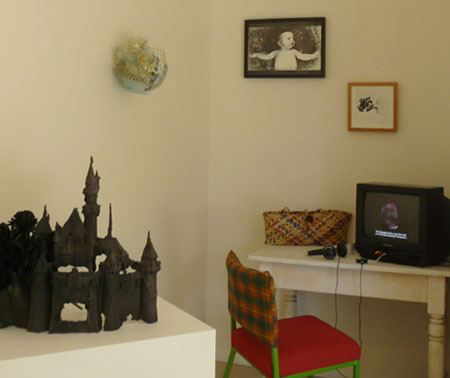
Left to Right: The Happiest place on earth, plastic, paint and artifical flowers by Brit Bunkley; Enclosure No. 1 wire netting + paperpulp by Michelle Backhouse; The Image (The spectacle is mesmeric in order to be successful), silkscreen print and mixed media (More >>) + Where change is barely visible, 2008, laser print by Sonja van Kerkhoff; Kete Whakairo (on table), dyed flax basket by Brenda Tuuta; Et in Arcadia Ego, 29 min video by Channa Boon.
The works surrounding this video were a pull and push on this theme of the romantic: Michelle Backhouse’s wire grid in colours that referenced nature and yet were unnatural in a formation that was both plant-like and yet inorganically abstract, woven baskets by Brenda Tuuta and Adrienne Spratt juxtaposed with works bearing politicized texts, and Brit Bunkley’s plastic model of the Disneyland castle recast as a ruin.
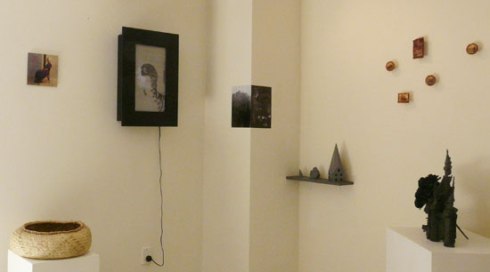
Left to Right: Mauri, harakeke, raranga (Māori weaving techniques) by Adrienne Spratt; Josephine’s Mother, print on aluminium, acrylic and varnish by Sonja van Kerkhoff (More >>); Bird of Prey, mixed media video loop by Sanne Maes; Untitled + Dark Entries, black and white photographs + The Speed of Dark, models on a shelf by Thom Vink; Warm Memories, photographic emulsion on teabags + magnets by Martje Zandboer and The Happiest place on earth, plastic, paint and artifical flowers, 55 x 45 x 10 cm, by Brit Bunkley (More >>).
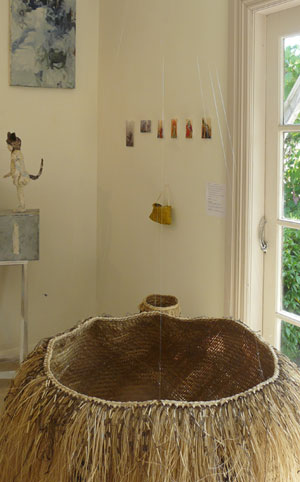
Left to Right: detail of Girl with Iberian Lynx by Michelle Backhouse; Oil on canvas by Edward Walton; From the War / No War series, six laser print on card reliefs, each is 10 x 15 x 2 cm, by Hohepa; Poutama (Step pattern), cylinder shaped basket + Herenga rahi (Big connections/confinement), harakeke, muka, tanekaha bark and paru dyes. Raranga, whatu (Māori weaving techniques) by Adrienne Spratt.
Martje Zandboer’s suspended photographic emulsion teabags, Thom Vink’s models and photographs and Sanne Maes’ mixed media video loop develop this pull and push into dialogue between the familiar and the other, estranged or mysterious. Adrienne Spratt’s basket below, reads as an empty vessel while its title alludes to a spirit filled essence.
On the other side of the gallery space are two more woven vessels by Adrienne Spratt. The enormous basket sways from numerous lines. Its title refers to both connection and enclosure.
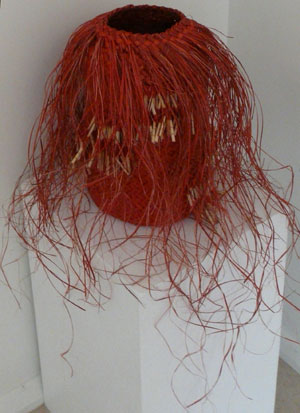
Pouhine, Harakeke, muka, commercial dyes. Raranga and whatu techniques by Adrienne Spratt.
Edward Walton’s gestural abstract paintings are like signatures or ‘nature traces’ while Michelle Backhouse’s paper pulp, building paper and mixed media,
Girl with Iberian Lynx, from the species facing extinction series, references the tangible topic of environmental responsibility.
On the adjacent wall a frieze relief of reproductions of paintings from Hohepa’s War / No War series uses Maori cultural symbols as commentary issues of the day. Below this is a small purse-like open pingao (a New Zealand natuve yellow grass) basket by Brenda Tuuta.
In another corner lines flow out from the red basket, Pouhine by Adrienne Spratt, which blur its contours. The title refers to the pattern woven into the sides.
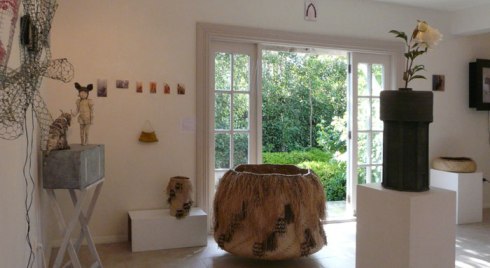
Left ot Right: Detail of Into the Pink, wire and paper pulp + Girl with Iberian Lynx by Michelle Backhouse; From the War / No War series, six laser print on card reliefs, each is 10 x 15 cm, by Hohepa; Kete Pingao, 20 x 10 cm, woven basket by Brenda Tuuta; Poutama (Step pattern), cylinder shaped basket + Herenga rahi (Big connections/confinement), harakeke, muka, tanekaha bark and paru dyes. Raranga, whatu (Māori weaving techniques) by Adrienne Spratt, Paewae (Threshold), aluminium print (above doorway) by Sonja van Kerkhoff; Lake Alice Water-tower, plastic sculpture by Brit Bunkley; Josephine’s Mother, print on aluminium, acrylic and varnish by Sonja van Kerkhoff; Mauri (essence/spirit), harakeke, raranga (Māori weaving techniques) by Adrienne Spratt; Detail of Bird of Prey, mixed media video loop by Sanne Maes.
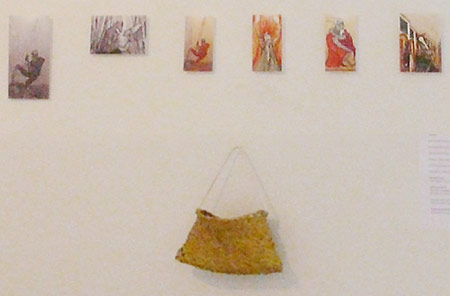
Left to Right: From the War / No War series: Warrior with Taiaha, Patu-paiarehe lovers, black and white laser prints on card, Warrior with Taiaha, Mākutu, No more war with Taiaha laid down, Rangatahi, colour laser prints on card, each piece approx. 10 x 15 x 2 cm, by Hohepa; Kete Pingao, 20 x 10 cm, woven basket by Brenda Tuuta.
The heart of Hohepa’s work is a dialectical process – fed from his Māori heritage. He descends from the tribes: Ngāti Whakaue, Tuhourangi, Tuwharetoa ki te Aupouri, Tapu Ika, Rangitihi, Uenukukopako, Te Arawa, Ngāpuhi (Whangaroa), Ngāti Kai Tangata. These small reliefs are prints of 1 x 2 metre paintings from the
War / No War series exhibited in 2017 in the Chiesa San Antonio, Lecce, a Baroque church in southern Italy.
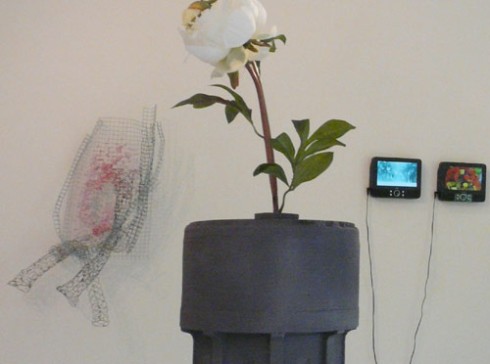
Left to Right: Into the pink, wire and acrylic, by Michelle Backhouse; Detail: Lake Alice Water-tower, plastic, paint and artificial flowers by Brit Bunkley; Cleaning the Air, 43 sec video + Daily Dishes, 7 min 11 sec video by Pietertje van Splunter.
The video
Cleaning the Air is actually a recording of a mobile sculpture which animates various household cleaning objects while in the video,
Daily Dishes, the mundane chore of doing the dishes is turned into an animation of colour and pattern.
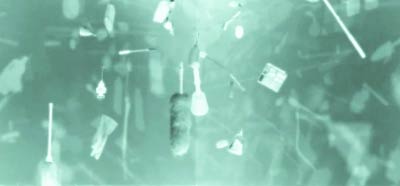
Still from Cleaning the Air by Pietertje van Splunter.
Pietertje van Splunter’s videos are like a poetics on the mundane: housework. Her brooms seem animated by an unearthly force and the constant stacking of the differing tribes of kitchen utensils suggests a game with secret rules. In using humour with the overkill her videos are reminders that the everyday domestic, is also a microcosm of the amusing, perhaps necessary banality of habit while Michelle Backhouse’s sculptures use seemingly banal materials, building paper, netting or house paint to create ethereal protusions.
